Coca-Cola Company: Business Strategy, Environment, and Analysis
VerifiedAdded on 2023/01/13
|16
|5071
|38
Report
AI Summary
This report provides a comprehensive analysis of Coca-Cola's business strategy, examining its approach to achieving market dominance. The report begins with an introduction to business strategy and an overview of the Coca-Cola Company, highlighting its mission, vision, and objectives. Part A focuses on analyzing the impact of the macro environment using frameworks such as PESTLE analysis, which assesses political, economic, social, technological, legal, and environmental factors. It also includes an organizational audit using SWOT analysis to evaluate strengths, weaknesses, opportunities, and threats. Part B delves into the internal environment and strategic capabilities, employing the McKinsey 7-S model to assess strategy, structure, systems, shared values, skills, style, and staff. The VRIO analysis is also applied to evaluate the resources and capabilities. Additionally, the report uses Porter's Five Forces model to evaluate the competitive forces within the market sector. Finally, the report applies various theories and concepts to devise strategic planning, and concludes with a summary of the findings and references.

Business Strategy
Paraphrase This Document
Need a fresh take? Get an instant paraphrase of this document with our AI Paraphraser

Table of Contents
INTRODUCTION...........................................................................................................................1
PART A...........................................................................................................................................1
Applying appropriate framework for analysing impacts of macro environment on company
and strategies................................................................................................................................1
Analysing internal environment together with capabilities of chosen form with appropriate
frameworks..................................................................................................................................5
Applying Porter's Five Force for the purpose of evaluating competitive forces of specific
market sector................................................................................................................................7
PART B..........................................................................................................................................10
Applying various theories, concepts and devising strategic planning.......................................10
CONCLUSION..............................................................................................................................13
REFERENCE.................................................................................................................................14
INTRODUCTION...........................................................................................................................1
PART A...........................................................................................................................................1
Applying appropriate framework for analysing impacts of macro environment on company
and strategies................................................................................................................................1
Analysing internal environment together with capabilities of chosen form with appropriate
frameworks..................................................................................................................................5
Applying Porter's Five Force for the purpose of evaluating competitive forces of specific
market sector................................................................................................................................7
PART B..........................................................................................................................................10
Applying various theories, concepts and devising strategic planning.......................................10
CONCLUSION..............................................................................................................................13
REFERENCE.................................................................................................................................14
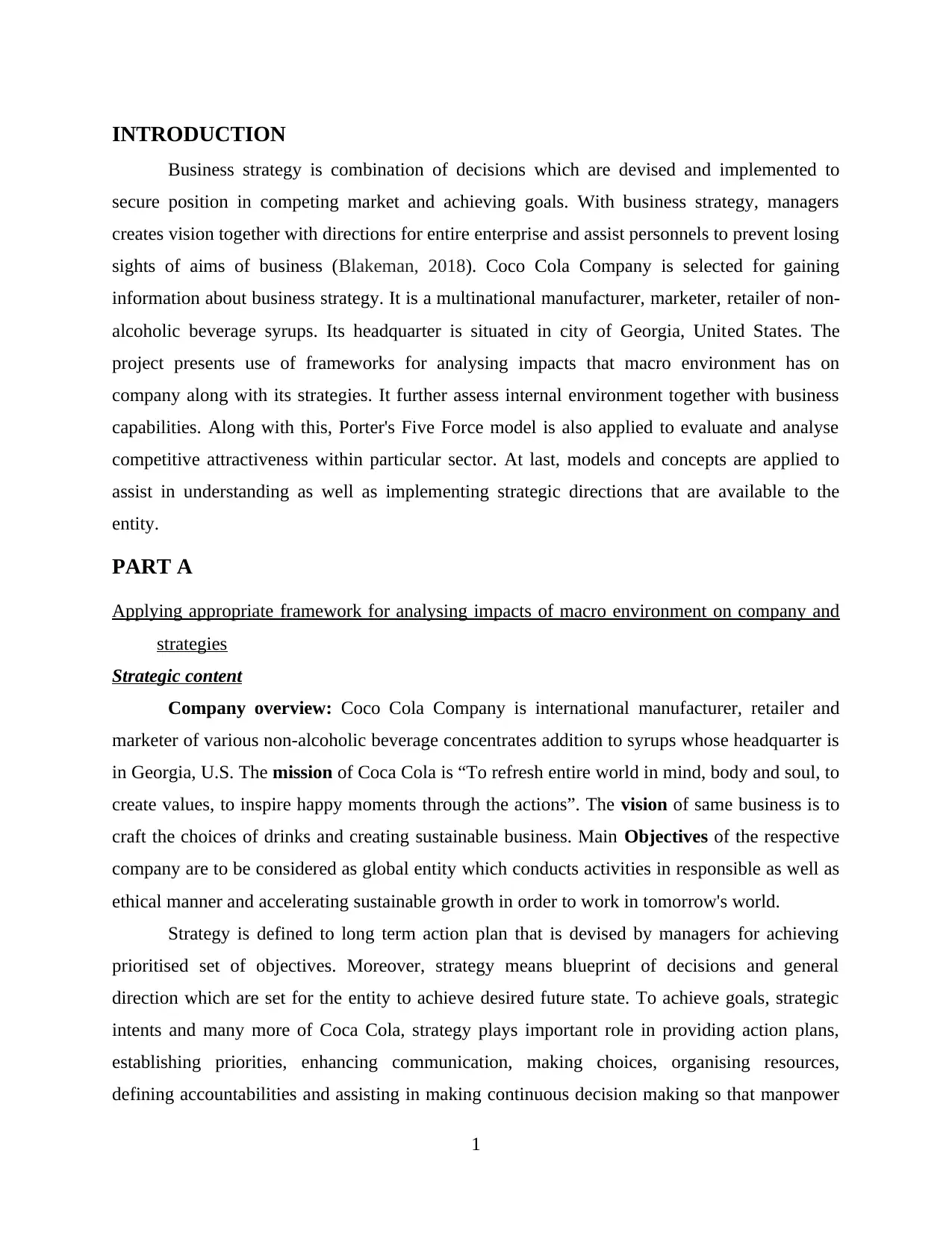
INTRODUCTION
Business strategy is combination of decisions which are devised and implemented to
secure position in competing market and achieving goals. With business strategy, managers
creates vision together with directions for entire enterprise and assist personnels to prevent losing
sights of aims of business (Blakeman, 2018). Coco Cola Company is selected for gaining
information about business strategy. It is a multinational manufacturer, marketer, retailer of non-
alcoholic beverage syrups. Its headquarter is situated in city of Georgia, United States. The
project presents use of frameworks for analysing impacts that macro environment has on
company along with its strategies. It further assess internal environment together with business
capabilities. Along with this, Porter's Five Force model is also applied to evaluate and analyse
competitive attractiveness within particular sector. At last, models and concepts are applied to
assist in understanding as well as implementing strategic directions that are available to the
entity.
PART A
Applying appropriate framework for analysing impacts of macro environment on company and
strategies
Strategic content
Company overview: Coco Cola Company is international manufacturer, retailer and
marketer of various non-alcoholic beverage concentrates addition to syrups whose headquarter is
in Georgia, U.S. The mission of Coca Cola is “To refresh entire world in mind, body and soul, to
create values, to inspire happy moments through the actions”. The vision of same business is to
craft the choices of drinks and creating sustainable business. Main Objectives of the respective
company are to be considered as global entity which conducts activities in responsible as well as
ethical manner and accelerating sustainable growth in order to work in tomorrow's world.
Strategy is defined to long term action plan that is devised by managers for achieving
prioritised set of objectives. Moreover, strategy means blueprint of decisions and general
direction which are set for the entity to achieve desired future state. To achieve goals, strategic
intents and many more of Coca Cola, strategy plays important role in providing action plans,
establishing priorities, enhancing communication, making choices, organising resources,
defining accountabilities and assisting in making continuous decision making so that manpower
1
Business strategy is combination of decisions which are devised and implemented to
secure position in competing market and achieving goals. With business strategy, managers
creates vision together with directions for entire enterprise and assist personnels to prevent losing
sights of aims of business (Blakeman, 2018). Coco Cola Company is selected for gaining
information about business strategy. It is a multinational manufacturer, marketer, retailer of non-
alcoholic beverage syrups. Its headquarter is situated in city of Georgia, United States. The
project presents use of frameworks for analysing impacts that macro environment has on
company along with its strategies. It further assess internal environment together with business
capabilities. Along with this, Porter's Five Force model is also applied to evaluate and analyse
competitive attractiveness within particular sector. At last, models and concepts are applied to
assist in understanding as well as implementing strategic directions that are available to the
entity.
PART A
Applying appropriate framework for analysing impacts of macro environment on company and
strategies
Strategic content
Company overview: Coco Cola Company is international manufacturer, retailer and
marketer of various non-alcoholic beverage concentrates addition to syrups whose headquarter is
in Georgia, U.S. The mission of Coca Cola is “To refresh entire world in mind, body and soul, to
create values, to inspire happy moments through the actions”. The vision of same business is to
craft the choices of drinks and creating sustainable business. Main Objectives of the respective
company are to be considered as global entity which conducts activities in responsible as well as
ethical manner and accelerating sustainable growth in order to work in tomorrow's world.
Strategy is defined to long term action plan that is devised by managers for achieving
prioritised set of objectives. Moreover, strategy means blueprint of decisions and general
direction which are set for the entity to achieve desired future state. To achieve goals, strategic
intents and many more of Coca Cola, strategy plays important role in providing action plans,
establishing priorities, enhancing communication, making choices, organising resources,
defining accountabilities and assisting in making continuous decision making so that manpower
1
⊘ This is a preview!⊘
Do you want full access?
Subscribe today to unlock all pages.

Trusted by 1+ million students worldwide
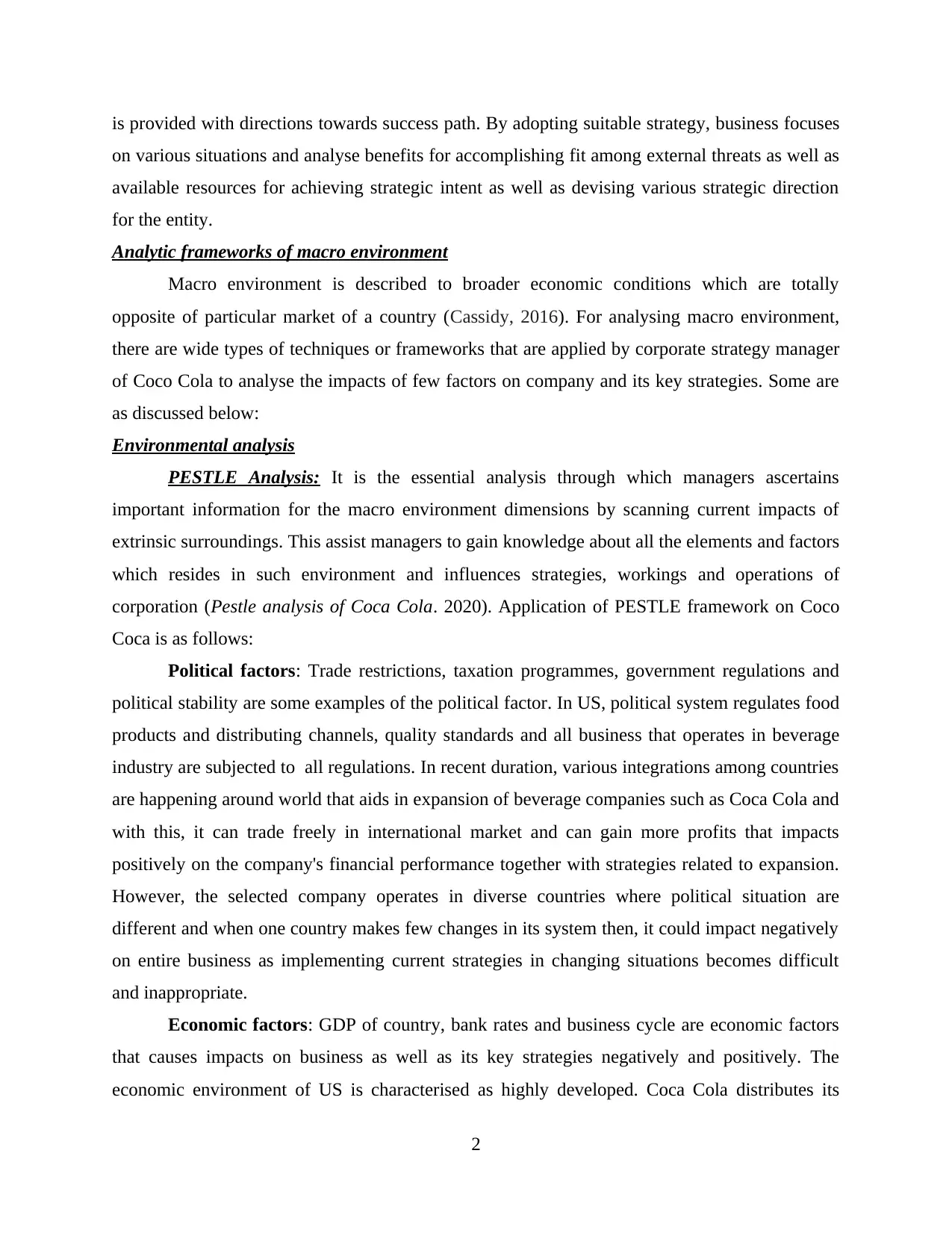
is provided with directions towards success path. By adopting suitable strategy, business focuses
on various situations and analyse benefits for accomplishing fit among external threats as well as
available resources for achieving strategic intent as well as devising various strategic direction
for the entity.
Analytic frameworks of macro environment
Macro environment is described to broader economic conditions which are totally
opposite of particular market of a country (Cassidy, 2016). For analysing macro environment,
there are wide types of techniques or frameworks that are applied by corporate strategy manager
of Coco Cola to analyse the impacts of few factors on company and its key strategies. Some are
as discussed below:
Environmental analysis
PESTLE Analysis: It is the essential analysis through which managers ascertains
important information for the macro environment dimensions by scanning current impacts of
extrinsic surroundings. This assist managers to gain knowledge about all the elements and factors
which resides in such environment and influences strategies, workings and operations of
corporation (Pestle analysis of Coca Cola. 2020). Application of PESTLE framework on Coco
Coca is as follows:
Political factors: Trade restrictions, taxation programmes, government regulations and
political stability are some examples of the political factor. In US, political system regulates food
products and distributing channels, quality standards and all business that operates in beverage
industry are subjected to all regulations. In recent duration, various integrations among countries
are happening around world that aids in expansion of beverage companies such as Coca Cola and
with this, it can trade freely in international market and can gain more profits that impacts
positively on the company's financial performance together with strategies related to expansion.
However, the selected company operates in diverse countries where political situation are
different and when one country makes few changes in its system then, it could impact negatively
on entire business as implementing current strategies in changing situations becomes difficult
and inappropriate.
Economic factors: GDP of country, bank rates and business cycle are economic factors
that causes impacts on business as well as its key strategies negatively and positively. The
economic environment of US is characterised as highly developed. Coca Cola distributes its
2
on various situations and analyse benefits for accomplishing fit among external threats as well as
available resources for achieving strategic intent as well as devising various strategic direction
for the entity.
Analytic frameworks of macro environment
Macro environment is described to broader economic conditions which are totally
opposite of particular market of a country (Cassidy, 2016). For analysing macro environment,
there are wide types of techniques or frameworks that are applied by corporate strategy manager
of Coco Cola to analyse the impacts of few factors on company and its key strategies. Some are
as discussed below:
Environmental analysis
PESTLE Analysis: It is the essential analysis through which managers ascertains
important information for the macro environment dimensions by scanning current impacts of
extrinsic surroundings. This assist managers to gain knowledge about all the elements and factors
which resides in such environment and influences strategies, workings and operations of
corporation (Pestle analysis of Coca Cola. 2020). Application of PESTLE framework on Coco
Coca is as follows:
Political factors: Trade restrictions, taxation programmes, government regulations and
political stability are some examples of the political factor. In US, political system regulates food
products and distributing channels, quality standards and all business that operates in beverage
industry are subjected to all regulations. In recent duration, various integrations among countries
are happening around world that aids in expansion of beverage companies such as Coca Cola and
with this, it can trade freely in international market and can gain more profits that impacts
positively on the company's financial performance together with strategies related to expansion.
However, the selected company operates in diverse countries where political situation are
different and when one country makes few changes in its system then, it could impact negatively
on entire business as implementing current strategies in changing situations becomes difficult
and inappropriate.
Economic factors: GDP of country, bank rates and business cycle are economic factors
that causes impacts on business as well as its key strategies negatively and positively. The
economic environment of US is characterised as highly developed. Coca Cola distributes its
2
Paraphrase This Document
Need a fresh take? Get an instant paraphrase of this document with our AI Paraphraser
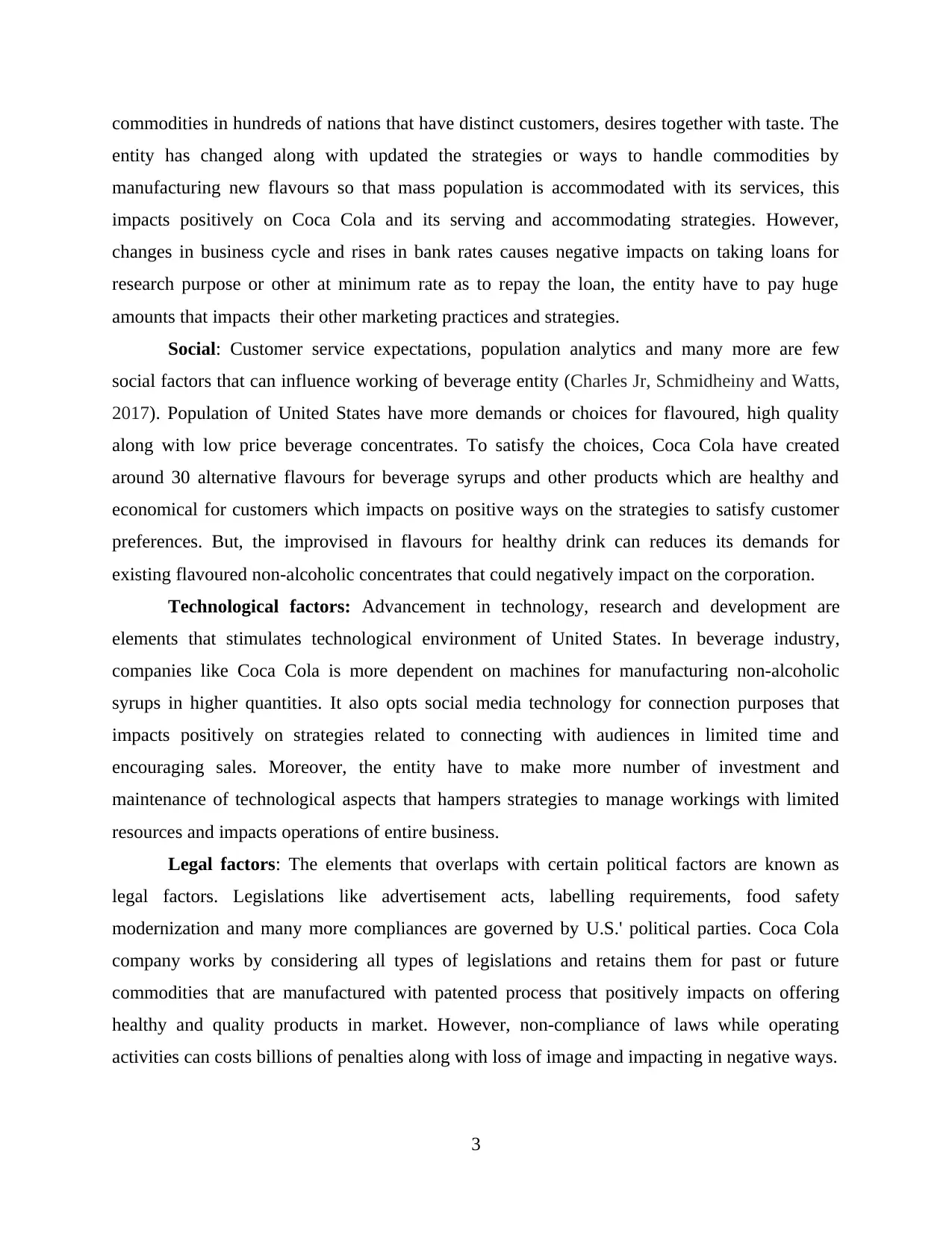
commodities in hundreds of nations that have distinct customers, desires together with taste. The
entity has changed along with updated the strategies or ways to handle commodities by
manufacturing new flavours so that mass population is accommodated with its services, this
impacts positively on Coca Cola and its serving and accommodating strategies. However,
changes in business cycle and rises in bank rates causes negative impacts on taking loans for
research purpose or other at minimum rate as to repay the loan, the entity have to pay huge
amounts that impacts their other marketing practices and strategies.
Social: Customer service expectations, population analytics and many more are few
social factors that can influence working of beverage entity (Charles Jr, Schmidheiny and Watts,
2017). Population of United States have more demands or choices for flavoured, high quality
along with low price beverage concentrates. To satisfy the choices, Coca Cola have created
around 30 alternative flavours for beverage syrups and other products which are healthy and
economical for customers which impacts on positive ways on the strategies to satisfy customer
preferences. But, the improvised in flavours for healthy drink can reduces its demands for
existing flavoured non-alcoholic concentrates that could negatively impact on the corporation.
Technological factors: Advancement in technology, research and development are
elements that stimulates technological environment of United States. In beverage industry,
companies like Coca Cola is more dependent on machines for manufacturing non-alcoholic
syrups in higher quantities. It also opts social media technology for connection purposes that
impacts positively on strategies related to connecting with audiences in limited time and
encouraging sales. Moreover, the entity have to make more number of investment and
maintenance of technological aspects that hampers strategies to manage workings with limited
resources and impacts operations of entire business.
Legal factors: The elements that overlaps with certain political factors are known as
legal factors. Legislations like advertisement acts, labelling requirements, food safety
modernization and many more compliances are governed by U.S.' political parties. Coca Cola
company works by considering all types of legislations and retains them for past or future
commodities that are manufactured with patented process that positively impacts on offering
healthy and quality products in market. However, non-compliance of laws while operating
activities can costs billions of penalties along with loss of image and impacting in negative ways.
3
entity has changed along with updated the strategies or ways to handle commodities by
manufacturing new flavours so that mass population is accommodated with its services, this
impacts positively on Coca Cola and its serving and accommodating strategies. However,
changes in business cycle and rises in bank rates causes negative impacts on taking loans for
research purpose or other at minimum rate as to repay the loan, the entity have to pay huge
amounts that impacts their other marketing practices and strategies.
Social: Customer service expectations, population analytics and many more are few
social factors that can influence working of beverage entity (Charles Jr, Schmidheiny and Watts,
2017). Population of United States have more demands or choices for flavoured, high quality
along with low price beverage concentrates. To satisfy the choices, Coca Cola have created
around 30 alternative flavours for beverage syrups and other products which are healthy and
economical for customers which impacts on positive ways on the strategies to satisfy customer
preferences. But, the improvised in flavours for healthy drink can reduces its demands for
existing flavoured non-alcoholic concentrates that could negatively impact on the corporation.
Technological factors: Advancement in technology, research and development are
elements that stimulates technological environment of United States. In beverage industry,
companies like Coca Cola is more dependent on machines for manufacturing non-alcoholic
syrups in higher quantities. It also opts social media technology for connection purposes that
impacts positively on strategies related to connecting with audiences in limited time and
encouraging sales. Moreover, the entity have to make more number of investment and
maintenance of technological aspects that hampers strategies to manage workings with limited
resources and impacts operations of entire business.
Legal factors: The elements that overlaps with certain political factors are known as
legal factors. Legislations like advertisement acts, labelling requirements, food safety
modernization and many more compliances are governed by U.S.' political parties. Coca Cola
company works by considering all types of legislations and retains them for past or future
commodities that are manufactured with patented process that positively impacts on offering
healthy and quality products in market. However, non-compliance of laws while operating
activities can costs billions of penalties along with loss of image and impacting in negative ways.
3
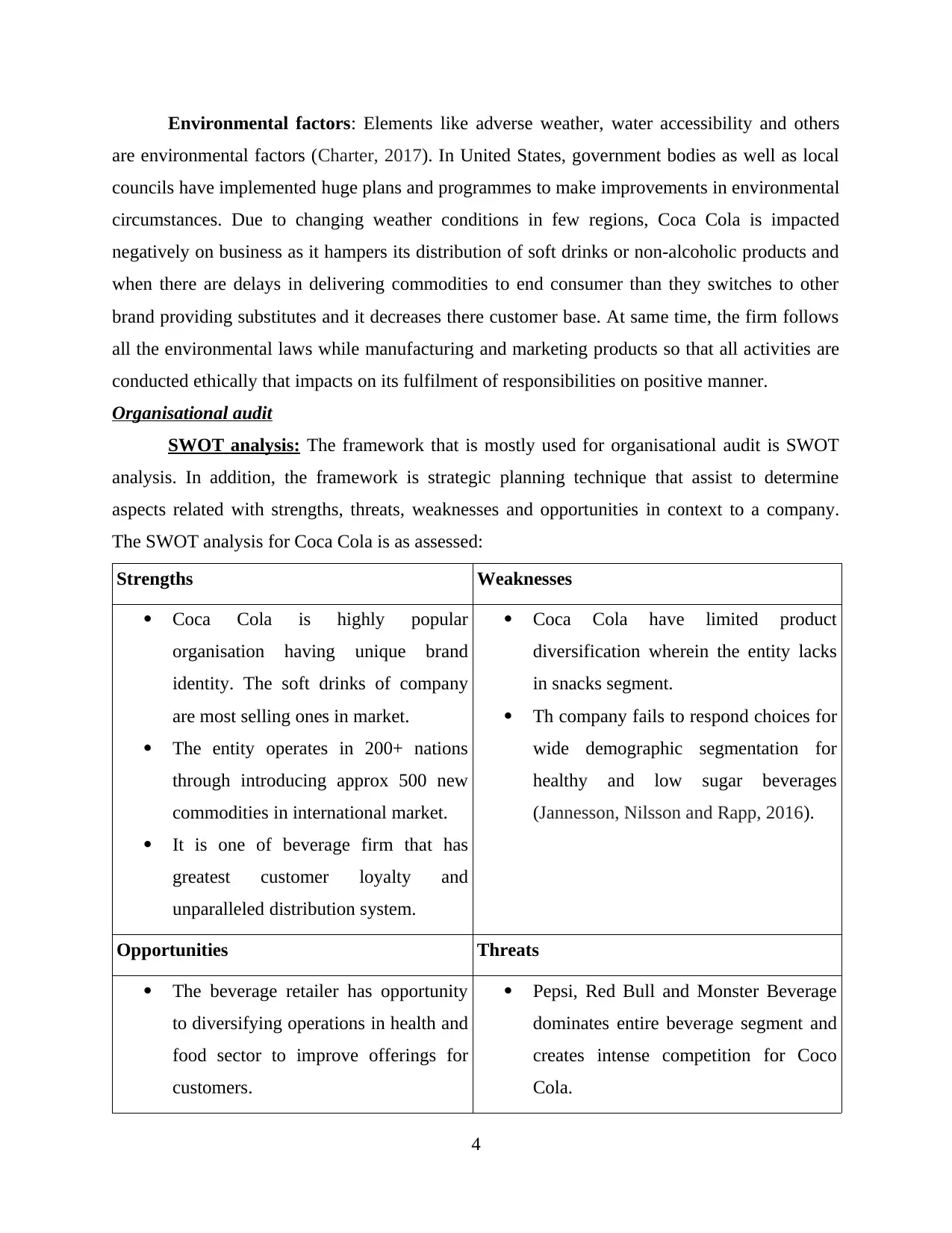
Environmental factors: Elements like adverse weather, water accessibility and others
are environmental factors (Charter, 2017). In United States, government bodies as well as local
councils have implemented huge plans and programmes to make improvements in environmental
circumstances. Due to changing weather conditions in few regions, Coca Cola is impacted
negatively on business as it hampers its distribution of soft drinks or non-alcoholic products and
when there are delays in delivering commodities to end consumer than they switches to other
brand providing substitutes and it decreases there customer base. At same time, the firm follows
all the environmental laws while manufacturing and marketing products so that all activities are
conducted ethically that impacts on its fulfilment of responsibilities on positive manner.
Organisational audit
SWOT analysis: The framework that is mostly used for organisational audit is SWOT
analysis. In addition, the framework is strategic planning technique that assist to determine
aspects related with strengths, threats, weaknesses and opportunities in context to a company.
The SWOT analysis for Coca Cola is as assessed:
Strengths Weaknesses
Coca Cola is highly popular
organisation having unique brand
identity. The soft drinks of company
are most selling ones in market.
The entity operates in 200+ nations
through introducing approx 500 new
commodities in international market.
It is one of beverage firm that has
greatest customer loyalty and
unparalleled distribution system.
Coca Cola have limited product
diversification wherein the entity lacks
in snacks segment.
Th company fails to respond choices for
wide demographic segmentation for
healthy and low sugar beverages
(Jannesson, Nilsson and Rapp, 2016).
Opportunities Threats
The beverage retailer has opportunity
to diversifying operations in health and
food sector to improve offerings for
customers.
Pepsi, Red Bull and Monster Beverage
dominates entire beverage segment and
creates intense competition for Coco
Cola.
4
are environmental factors (Charter, 2017). In United States, government bodies as well as local
councils have implemented huge plans and programmes to make improvements in environmental
circumstances. Due to changing weather conditions in few regions, Coca Cola is impacted
negatively on business as it hampers its distribution of soft drinks or non-alcoholic products and
when there are delays in delivering commodities to end consumer than they switches to other
brand providing substitutes and it decreases there customer base. At same time, the firm follows
all the environmental laws while manufacturing and marketing products so that all activities are
conducted ethically that impacts on its fulfilment of responsibilities on positive manner.
Organisational audit
SWOT analysis: The framework that is mostly used for organisational audit is SWOT
analysis. In addition, the framework is strategic planning technique that assist to determine
aspects related with strengths, threats, weaknesses and opportunities in context to a company.
The SWOT analysis for Coca Cola is as assessed:
Strengths Weaknesses
Coca Cola is highly popular
organisation having unique brand
identity. The soft drinks of company
are most selling ones in market.
The entity operates in 200+ nations
through introducing approx 500 new
commodities in international market.
It is one of beverage firm that has
greatest customer loyalty and
unparalleled distribution system.
Coca Cola have limited product
diversification wherein the entity lacks
in snacks segment.
Th company fails to respond choices for
wide demographic segmentation for
healthy and low sugar beverages
(Jannesson, Nilsson and Rapp, 2016).
Opportunities Threats
The beverage retailer has opportunity
to diversifying operations in health and
food sector to improve offerings for
customers.
Pepsi, Red Bull and Monster Beverage
dominates entire beverage segment and
creates intense competition for Coco
Cola.
4
⊘ This is a preview!⊘
Do you want full access?
Subscribe today to unlock all pages.

Trusted by 1+ million students worldwide

Improvement in existing supply chain
and reducing costs related to
transportation and distribution is also
an effective opportunity to make
profits.
The selected company was part of
criticisms related to water management
issue and mixing pesticide is leading
threat for it.
Analysing internal environment together with capabilities of chosen form with appropriate
frameworks
Strategic capabilities are defines as potentials of company for harnessing skills,
competence, capabilities and resources to gain benefits and sustainability in competition so that
values are enhanced with time (Johnson, 2016). Analysis tools, goals, strategic purpose and
planning actions are certain components related to strategic capabilities.
McKinsey's 7s model
The management tool which elaborates linkage within seven elements which are
generally aligned for accomplishing goals. The elements which are part of the model in
association with Coca Cola are underneath:
Strategy: The plan developed for accomplishing sustained competitive benefits along
with successfully competing with rivals is strategy. Management team of Coca Cola implements
huge kinds of strategies including corporate strategy, R&C Strategy, functional strategy and
operational strategies for achieving all the set objectives promptly.
System: The element is said to organisational procedures together with process that
reveals its day to day tasks as well as decision making ways (Kingsnorth, 2019). Moreover,
these are the areas which determines workings of business and is main concentrating of
managers at the time of changes. Corporate strategy manager of the chosen beverage entity
emphasis on workplace system, process system, operational system and marketing system to
attain growth and expansion.
Structure: Information about the responsibility, accountability and authority are
determined by structure of company. It is business chart of entire company. At the workplace of
Coca Cola, regional structure is followed that combines localisation together with centralisation
of all operating segments in different areas with effective business unit teams.
5
and reducing costs related to
transportation and distribution is also
an effective opportunity to make
profits.
The selected company was part of
criticisms related to water management
issue and mixing pesticide is leading
threat for it.
Analysing internal environment together with capabilities of chosen form with appropriate
frameworks
Strategic capabilities are defines as potentials of company for harnessing skills,
competence, capabilities and resources to gain benefits and sustainability in competition so that
values are enhanced with time (Johnson, 2016). Analysis tools, goals, strategic purpose and
planning actions are certain components related to strategic capabilities.
McKinsey's 7s model
The management tool which elaborates linkage within seven elements which are
generally aligned for accomplishing goals. The elements which are part of the model in
association with Coca Cola are underneath:
Strategy: The plan developed for accomplishing sustained competitive benefits along
with successfully competing with rivals is strategy. Management team of Coca Cola implements
huge kinds of strategies including corporate strategy, R&C Strategy, functional strategy and
operational strategies for achieving all the set objectives promptly.
System: The element is said to organisational procedures together with process that
reveals its day to day tasks as well as decision making ways (Kingsnorth, 2019). Moreover,
these are the areas which determines workings of business and is main concentrating of
managers at the time of changes. Corporate strategy manager of the chosen beverage entity
emphasis on workplace system, process system, operational system and marketing system to
attain growth and expansion.
Structure: Information about the responsibility, accountability and authority are
determined by structure of company. It is business chart of entire company. At the workplace of
Coca Cola, regional structure is followed that combines localisation together with centralisation
of all operating segments in different areas with effective business unit teams.
5
Paraphrase This Document
Need a fresh take? Get an instant paraphrase of this document with our AI Paraphraser
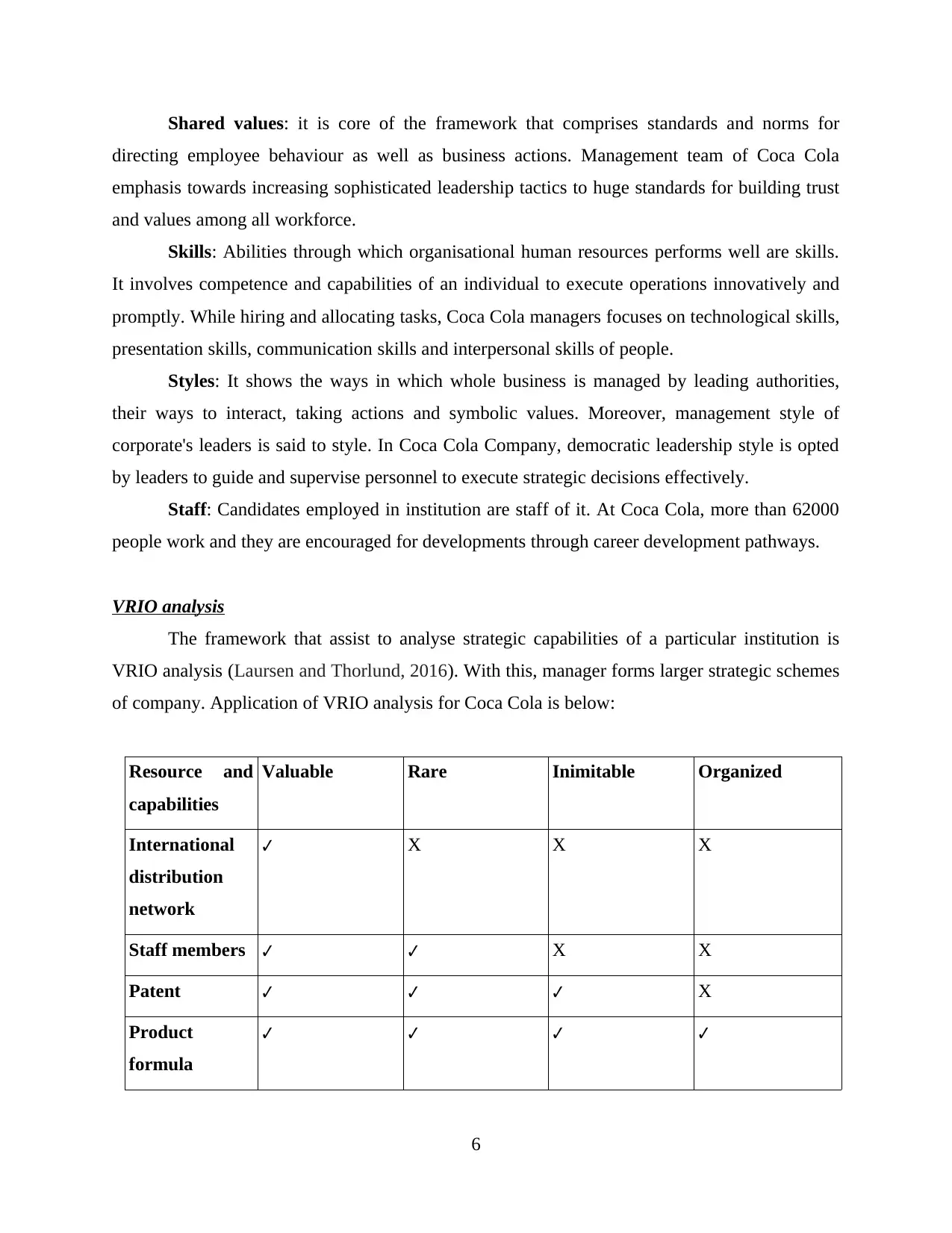
Shared values: it is core of the framework that comprises standards and norms for
directing employee behaviour as well as business actions. Management team of Coca Cola
emphasis towards increasing sophisticated leadership tactics to huge standards for building trust
and values among all workforce.
Skills: Abilities through which organisational human resources performs well are skills.
It involves competence and capabilities of an individual to execute operations innovatively and
promptly. While hiring and allocating tasks, Coca Cola managers focuses on technological skills,
presentation skills, communication skills and interpersonal skills of people.
Styles: It shows the ways in which whole business is managed by leading authorities,
their ways to interact, taking actions and symbolic values. Moreover, management style of
corporate's leaders is said to style. In Coca Cola Company, democratic leadership style is opted
by leaders to guide and supervise personnel to execute strategic decisions effectively.
Staff: Candidates employed in institution are staff of it. At Coca Cola, more than 62000
people work and they are encouraged for developments through career development pathways.
VRIO analysis
The framework that assist to analyse strategic capabilities of a particular institution is
VRIO analysis (Laursen and Thorlund, 2016). With this, manager forms larger strategic schemes
of company. Application of VRIO analysis for Coca Cola is below:
Resource and
capabilities
Valuable Rare Inimitable Organized
International
distribution
network
✔ X X X
Staff members ✔ ✔ X X
Patent ✔ ✔ ✔ X
Product
formula
✔ ✔ ✔ ✔
6
directing employee behaviour as well as business actions. Management team of Coca Cola
emphasis towards increasing sophisticated leadership tactics to huge standards for building trust
and values among all workforce.
Skills: Abilities through which organisational human resources performs well are skills.
It involves competence and capabilities of an individual to execute operations innovatively and
promptly. While hiring and allocating tasks, Coca Cola managers focuses on technological skills,
presentation skills, communication skills and interpersonal skills of people.
Styles: It shows the ways in which whole business is managed by leading authorities,
their ways to interact, taking actions and symbolic values. Moreover, management style of
corporate's leaders is said to style. In Coca Cola Company, democratic leadership style is opted
by leaders to guide and supervise personnel to execute strategic decisions effectively.
Staff: Candidates employed in institution are staff of it. At Coca Cola, more than 62000
people work and they are encouraged for developments through career development pathways.
VRIO analysis
The framework that assist to analyse strategic capabilities of a particular institution is
VRIO analysis (Laursen and Thorlund, 2016). With this, manager forms larger strategic schemes
of company. Application of VRIO analysis for Coca Cola is below:
Resource and
capabilities
Valuable Rare Inimitable Organized
International
distribution
network
✔ X X X
Staff members ✔ ✔ X X
Patent ✔ ✔ ✔ X
Product
formula
✔ ✔ ✔ ✔
6
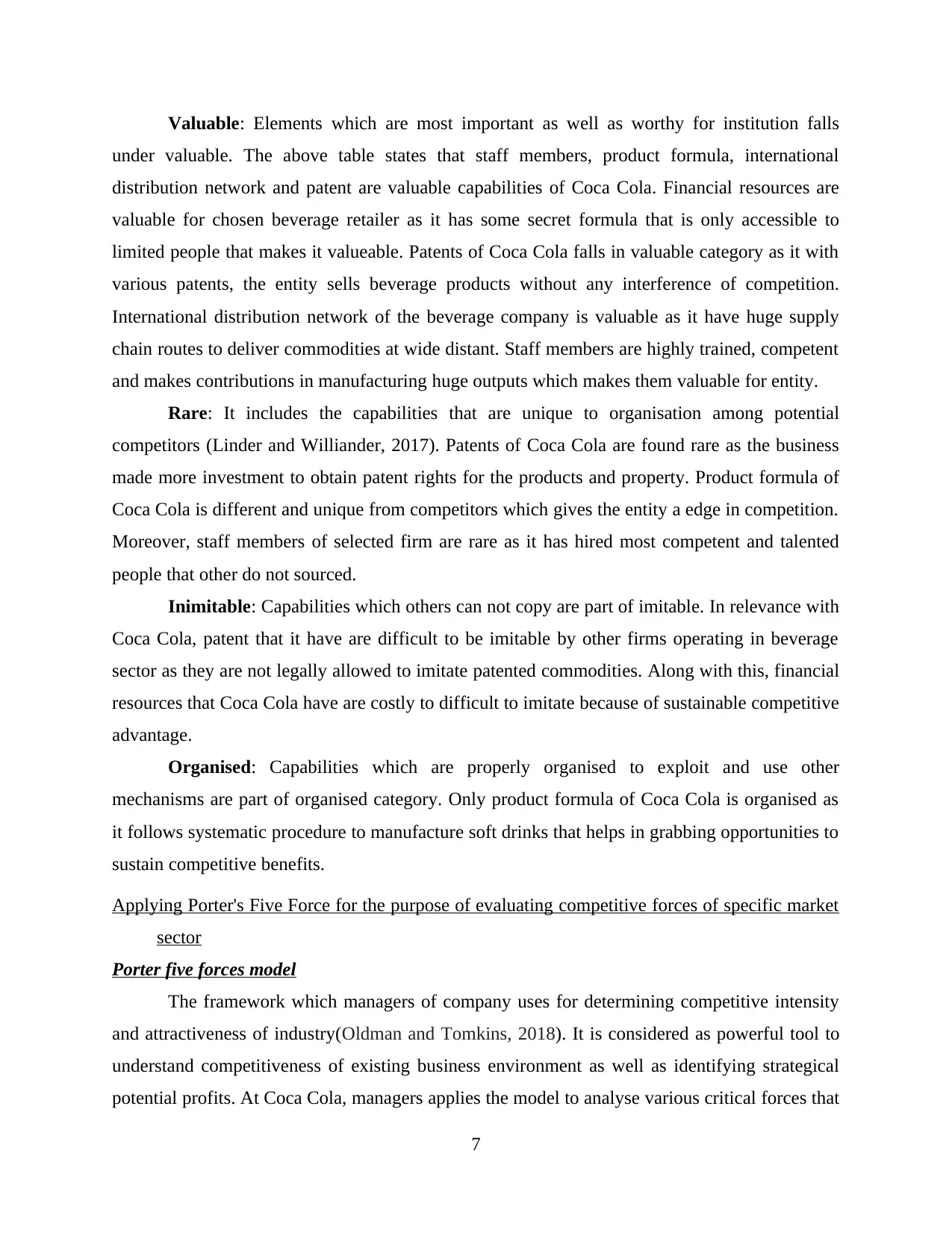
Valuable: Elements which are most important as well as worthy for institution falls
under valuable. The above table states that staff members, product formula, international
distribution network and patent are valuable capabilities of Coca Cola. Financial resources are
valuable for chosen beverage retailer as it has some secret formula that is only accessible to
limited people that makes it valueable. Patents of Coca Cola falls in valuable category as it with
various patents, the entity sells beverage products without any interference of competition.
International distribution network of the beverage company is valuable as it have huge supply
chain routes to deliver commodities at wide distant. Staff members are highly trained, competent
and makes contributions in manufacturing huge outputs which makes them valuable for entity.
Rare: It includes the capabilities that are unique to organisation among potential
competitors (Linder and Williander, 2017). Patents of Coca Cola are found rare as the business
made more investment to obtain patent rights for the products and property. Product formula of
Coca Cola is different and unique from competitors which gives the entity a edge in competition.
Moreover, staff members of selected firm are rare as it has hired most competent and talented
people that other do not sourced.
Inimitable: Capabilities which others can not copy are part of imitable. In relevance with
Coca Cola, patent that it have are difficult to be imitable by other firms operating in beverage
sector as they are not legally allowed to imitate patented commodities. Along with this, financial
resources that Coca Cola have are costly to difficult to imitate because of sustainable competitive
advantage.
Organised: Capabilities which are properly organised to exploit and use other
mechanisms are part of organised category. Only product formula of Coca Cola is organised as
it follows systematic procedure to manufacture soft drinks that helps in grabbing opportunities to
sustain competitive benefits.
Applying Porter's Five Force for the purpose of evaluating competitive forces of specific market
sector
Porter five forces model
The framework which managers of company uses for determining competitive intensity
and attractiveness of industry(Oldman and Tomkins, 2018). It is considered as powerful tool to
understand competitiveness of existing business environment as well as identifying strategical
potential profits. At Coca Cola, managers applies the model to analyse various critical forces that
7
under valuable. The above table states that staff members, product formula, international
distribution network and patent are valuable capabilities of Coca Cola. Financial resources are
valuable for chosen beverage retailer as it has some secret formula that is only accessible to
limited people that makes it valueable. Patents of Coca Cola falls in valuable category as it with
various patents, the entity sells beverage products without any interference of competition.
International distribution network of the beverage company is valuable as it have huge supply
chain routes to deliver commodities at wide distant. Staff members are highly trained, competent
and makes contributions in manufacturing huge outputs which makes them valuable for entity.
Rare: It includes the capabilities that are unique to organisation among potential
competitors (Linder and Williander, 2017). Patents of Coca Cola are found rare as the business
made more investment to obtain patent rights for the products and property. Product formula of
Coca Cola is different and unique from competitors which gives the entity a edge in competition.
Moreover, staff members of selected firm are rare as it has hired most competent and talented
people that other do not sourced.
Inimitable: Capabilities which others can not copy are part of imitable. In relevance with
Coca Cola, patent that it have are difficult to be imitable by other firms operating in beverage
sector as they are not legally allowed to imitate patented commodities. Along with this, financial
resources that Coca Cola have are costly to difficult to imitate because of sustainable competitive
advantage.
Organised: Capabilities which are properly organised to exploit and use other
mechanisms are part of organised category. Only product formula of Coca Cola is organised as
it follows systematic procedure to manufacture soft drinks that helps in grabbing opportunities to
sustain competitive benefits.
Applying Porter's Five Force for the purpose of evaluating competitive forces of specific market
sector
Porter five forces model
The framework which managers of company uses for determining competitive intensity
and attractiveness of industry(Oldman and Tomkins, 2018). It is considered as powerful tool to
understand competitiveness of existing business environment as well as identifying strategical
potential profits. At Coca Cola, managers applies the model to analyse various critical forces that
7
⊘ This is a preview!⊘
Do you want full access?
Subscribe today to unlock all pages.

Trusted by 1+ million students worldwide

affects or influences industrial competition level. The forces of model in relevance with Coca
Cola are as discussed:
Illustration 1: Porter's five forces model, 2019
(Source: Porter's five forces model, 2019)
New Entrant threat: In present era, entire confectionery industry or sector is controlled
by established brands. The force determines entrance of new company in market. In case with
beverage industry, there is high entrant threats or barriers due to low cost required for setting
production unit addition to expenses of marketing for providing commodities available to
potential population. Being a recognised brand, new entrant threat is low for Coca Cola as for
new companies, it is difficult to attain top position like the selected entity in limited timings.
New entrant threat provide opportunity to analyse external market and devising suitable strategy.
But, also provides threat for low brand loyalty and reduction in market share when new company
enters in market.
Threat of substitutes: Substitutes are those items which provides similar satisfaction or
benefits to mass consumers (Orna, 2017). In context to Coca Cola, it has high substitute threat as
different substitutes such as soft drinks, bottled water as well as juices are available to consumers
8
Cola are as discussed:
Illustration 1: Porter's five forces model, 2019
(Source: Porter's five forces model, 2019)
New Entrant threat: In present era, entire confectionery industry or sector is controlled
by established brands. The force determines entrance of new company in market. In case with
beverage industry, there is high entrant threats or barriers due to low cost required for setting
production unit addition to expenses of marketing for providing commodities available to
potential population. Being a recognised brand, new entrant threat is low for Coca Cola as for
new companies, it is difficult to attain top position like the selected entity in limited timings.
New entrant threat provide opportunity to analyse external market and devising suitable strategy.
But, also provides threat for low brand loyalty and reduction in market share when new company
enters in market.
Threat of substitutes: Substitutes are those items which provides similar satisfaction or
benefits to mass consumers (Orna, 2017). In context to Coca Cola, it has high substitute threat as
different substitutes such as soft drinks, bottled water as well as juices are available to consumers
8
Paraphrase This Document
Need a fresh take? Get an instant paraphrase of this document with our AI Paraphraser
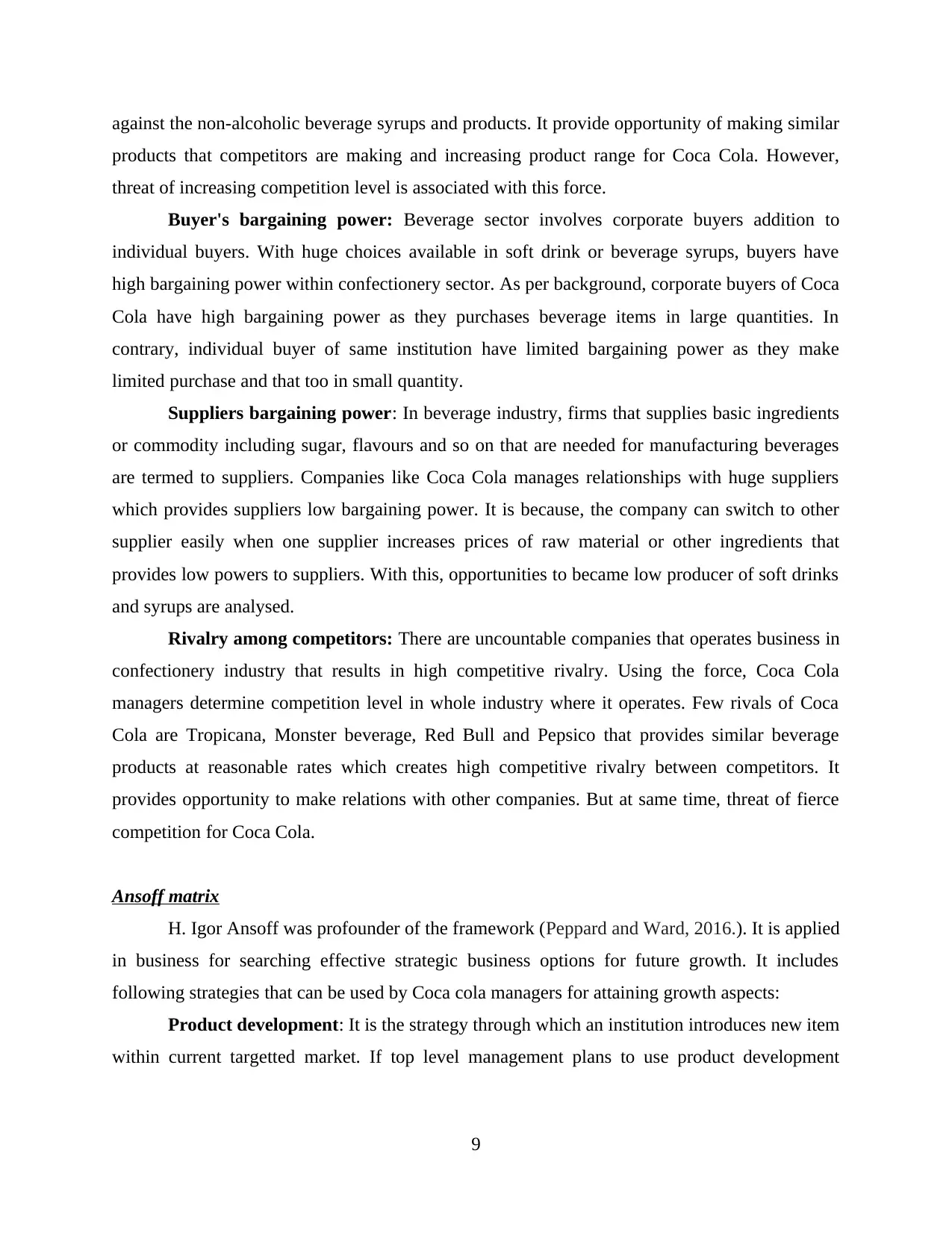
against the non-alcoholic beverage syrups and products. It provide opportunity of making similar
products that competitors are making and increasing product range for Coca Cola. However,
threat of increasing competition level is associated with this force.
Buyer's bargaining power: Beverage sector involves corporate buyers addition to
individual buyers. With huge choices available in soft drink or beverage syrups, buyers have
high bargaining power within confectionery sector. As per background, corporate buyers of Coca
Cola have high bargaining power as they purchases beverage items in large quantities. In
contrary, individual buyer of same institution have limited bargaining power as they make
limited purchase and that too in small quantity.
Suppliers bargaining power: In beverage industry, firms that supplies basic ingredients
or commodity including sugar, flavours and so on that are needed for manufacturing beverages
are termed to suppliers. Companies like Coca Cola manages relationships with huge suppliers
which provides suppliers low bargaining power. It is because, the company can switch to other
supplier easily when one supplier increases prices of raw material or other ingredients that
provides low powers to suppliers. With this, opportunities to became low producer of soft drinks
and syrups are analysed.
Rivalry among competitors: There are uncountable companies that operates business in
confectionery industry that results in high competitive rivalry. Using the force, Coca Cola
managers determine competition level in whole industry where it operates. Few rivals of Coca
Cola are Tropicana, Monster beverage, Red Bull and Pepsico that provides similar beverage
products at reasonable rates which creates high competitive rivalry between competitors. It
provides opportunity to make relations with other companies. But at same time, threat of fierce
competition for Coca Cola.
Ansoff matrix
H. Igor Ansoff was profounder of the framework (Peppard and Ward, 2016.). It is applied
in business for searching effective strategic business options for future growth. It includes
following strategies that can be used by Coca cola managers for attaining growth aspects:
Product development: It is the strategy through which an institution introduces new item
within current targetted market. If top level management plans to use product development
9
products that competitors are making and increasing product range for Coca Cola. However,
threat of increasing competition level is associated with this force.
Buyer's bargaining power: Beverage sector involves corporate buyers addition to
individual buyers. With huge choices available in soft drink or beverage syrups, buyers have
high bargaining power within confectionery sector. As per background, corporate buyers of Coca
Cola have high bargaining power as they purchases beverage items in large quantities. In
contrary, individual buyer of same institution have limited bargaining power as they make
limited purchase and that too in small quantity.
Suppliers bargaining power: In beverage industry, firms that supplies basic ingredients
or commodity including sugar, flavours and so on that are needed for manufacturing beverages
are termed to suppliers. Companies like Coca Cola manages relationships with huge suppliers
which provides suppliers low bargaining power. It is because, the company can switch to other
supplier easily when one supplier increases prices of raw material or other ingredients that
provides low powers to suppliers. With this, opportunities to became low producer of soft drinks
and syrups are analysed.
Rivalry among competitors: There are uncountable companies that operates business in
confectionery industry that results in high competitive rivalry. Using the force, Coca Cola
managers determine competition level in whole industry where it operates. Few rivals of Coca
Cola are Tropicana, Monster beverage, Red Bull and Pepsico that provides similar beverage
products at reasonable rates which creates high competitive rivalry between competitors. It
provides opportunity to make relations with other companies. But at same time, threat of fierce
competition for Coca Cola.
Ansoff matrix
H. Igor Ansoff was profounder of the framework (Peppard and Ward, 2016.). It is applied
in business for searching effective strategic business options for future growth. It includes
following strategies that can be used by Coca cola managers for attaining growth aspects:
Product development: It is the strategy through which an institution introduces new item
within current targetted market. If top level management plans to use product development
9
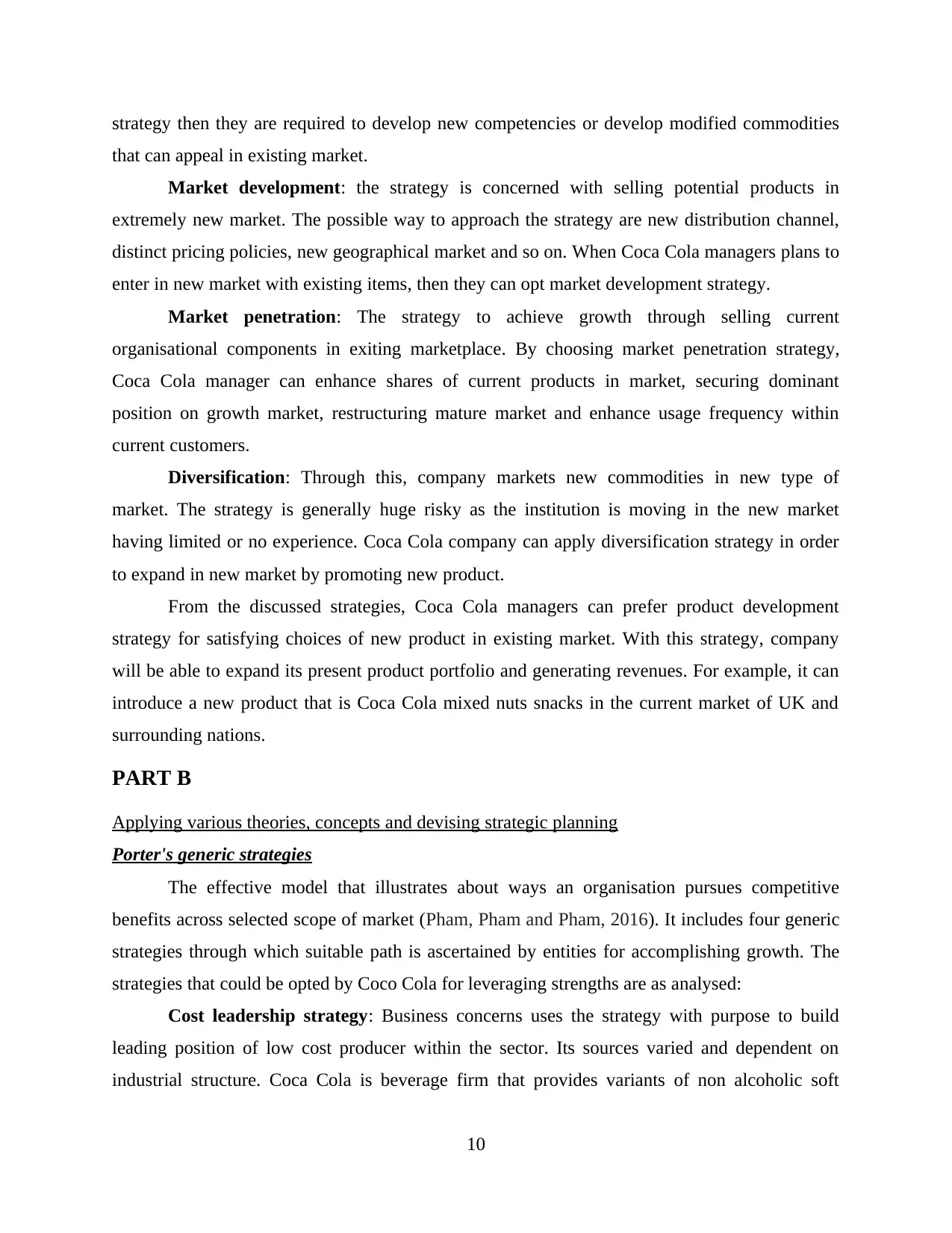
strategy then they are required to develop new competencies or develop modified commodities
that can appeal in existing market.
Market development: the strategy is concerned with selling potential products in
extremely new market. The possible way to approach the strategy are new distribution channel,
distinct pricing policies, new geographical market and so on. When Coca Cola managers plans to
enter in new market with existing items, then they can opt market development strategy.
Market penetration: The strategy to achieve growth through selling current
organisational components in exiting marketplace. By choosing market penetration strategy,
Coca Cola manager can enhance shares of current products in market, securing dominant
position on growth market, restructuring mature market and enhance usage frequency within
current customers.
Diversification: Through this, company markets new commodities in new type of
market. The strategy is generally huge risky as the institution is moving in the new market
having limited or no experience. Coca Cola company can apply diversification strategy in order
to expand in new market by promoting new product.
From the discussed strategies, Coca Cola managers can prefer product development
strategy for satisfying choices of new product in existing market. With this strategy, company
will be able to expand its present product portfolio and generating revenues. For example, it can
introduce a new product that is Coca Cola mixed nuts snacks in the current market of UK and
surrounding nations.
PART B
Applying various theories, concepts and devising strategic planning
Porter's generic strategies
The effective model that illustrates about ways an organisation pursues competitive
benefits across selected scope of market (Pham, Pham and Pham, 2016). It includes four generic
strategies through which suitable path is ascertained by entities for accomplishing growth. The
strategies that could be opted by Coco Cola for leveraging strengths are as analysed:
Cost leadership strategy: Business concerns uses the strategy with purpose to build
leading position of low cost producer within the sector. Its sources varied and dependent on
industrial structure. Coca Cola is beverage firm that provides variants of non alcoholic soft
10
that can appeal in existing market.
Market development: the strategy is concerned with selling potential products in
extremely new market. The possible way to approach the strategy are new distribution channel,
distinct pricing policies, new geographical market and so on. When Coca Cola managers plans to
enter in new market with existing items, then they can opt market development strategy.
Market penetration: The strategy to achieve growth through selling current
organisational components in exiting marketplace. By choosing market penetration strategy,
Coca Cola manager can enhance shares of current products in market, securing dominant
position on growth market, restructuring mature market and enhance usage frequency within
current customers.
Diversification: Through this, company markets new commodities in new type of
market. The strategy is generally huge risky as the institution is moving in the new market
having limited or no experience. Coca Cola company can apply diversification strategy in order
to expand in new market by promoting new product.
From the discussed strategies, Coca Cola managers can prefer product development
strategy for satisfying choices of new product in existing market. With this strategy, company
will be able to expand its present product portfolio and generating revenues. For example, it can
introduce a new product that is Coca Cola mixed nuts snacks in the current market of UK and
surrounding nations.
PART B
Applying various theories, concepts and devising strategic planning
Porter's generic strategies
The effective model that illustrates about ways an organisation pursues competitive
benefits across selected scope of market (Pham, Pham and Pham, 2016). It includes four generic
strategies through which suitable path is ascertained by entities for accomplishing growth. The
strategies that could be opted by Coco Cola for leveraging strengths are as analysed:
Cost leadership strategy: Business concerns uses the strategy with purpose to build
leading position of low cost producer within the sector. Its sources varied and dependent on
industrial structure. Coca Cola is beverage firm that provides variants of non alcoholic soft
10
⊘ This is a preview!⊘
Do you want full access?
Subscribe today to unlock all pages.

Trusted by 1+ million students worldwide
1 out of 16
Related Documents
Your All-in-One AI-Powered Toolkit for Academic Success.
+13062052269
info@desklib.com
Available 24*7 on WhatsApp / Email
![[object Object]](/_next/static/media/star-bottom.7253800d.svg)
Unlock your academic potential
Copyright © 2020–2025 A2Z Services. All Rights Reserved. Developed and managed by ZUCOL.



